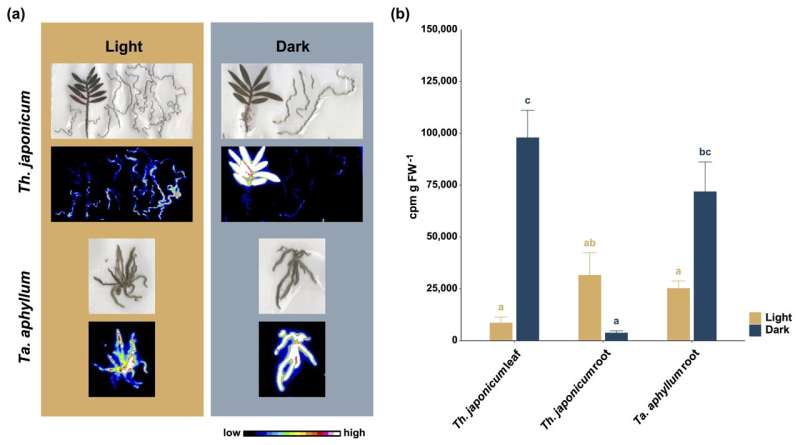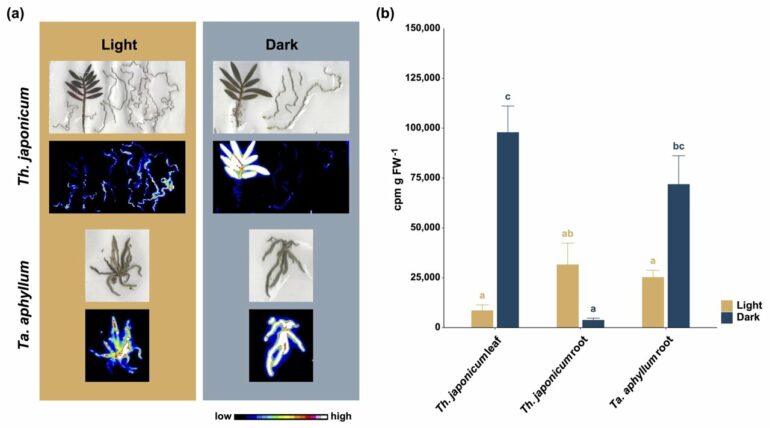Photosynthesis is the process whereby plants turn sunlight into the energy (sugars) that they need to survive and grow. For most plants, this happens in the leaves, which contain chlorophyll; a green pigment that is essential for photosynthesis as it absorbs light.
However, some plants have evolved unconventional ways of performing photosynthesis. Recently, Professor Suetsugu Kenji and colleagues discovered that a leafless epiphytic orchid can conduct sophisticated photosynthesis through its roots. Epiphytic plants are commonly called “air plants” because they grow on top of other plants or objects and are not attached to the ground.
Both the green roots of this particular leafless orchid and the leaves of a closely-related leafy orchid species show a considerable amount of photosynthetic pigment content, a high photosynthetic electron transport activity, and nocturnal CO2 uptake, as well as a high capacity for photosynthetic gas exchange. In other words, these discoveries indicate that its roots carry out photosynthesis in a similar manner to leaves.
The emergence of leaflessness as a distinct feature in plant evolution is a captivating and challenging topic, given the widely-held belief that leaves are highly specialized organs for photosynthesis. Nevertheless, some orchids possess chlorophyll-containing roots capable of photosynthesis, which contribute significantly to the plant’s photosynthetic and water absorption functions. Interestingly, certain epiphytic orchids, hereafter referred to as “leafless epiphytic orchids,” have green aerial roots, abbreviated stems, and highly reduced scale-like leaves.
Leafless epiphytic orchids display a unique type of leaflessness, which is characterized by the extensive reduction of their shoot, leading to no net carbon gain. The roots are the only organ that the plant can use to produce its own energy. Therefore, it is assumed that their roots would be more specialized for photosynthesis than those of closely-related leafy species. However, little is known about the photosynthetic function of leafless epiphytic orchids’ roots.
To tackle this knowledge gap, the researchers focused on the genus Taeniophyllum, which contains the majority of leafless epiphytic orchids. Luckily for comparison purposes, a Japanese Taeniophyllum species, T. aphyllum, often co-occurs with a leafy closely-related species Thrixspermum japonicum. The researchers’ objective was to improve understanding of how leafless epiphytic orchids carry out photosynthesis by comparing the photosynthetic properties of Ta. aphyllum aerial roots with those of Th. japonicum leaves and roots.

(A) Radioluminographs of plant organs (leaves and/or roots). Color bar scale shows relative 14C intensity. (B) 14C activity of plant organ samples, measured by liquid scintillation counting. Values and error bars indicate means ± SE. Different letters indicate statistically significant differences (p < 0.05). © Kenji Suetsugu
The results revealed that the photosynthetic efficiency of the roots of a leafless epiphytic orchid is significantly higher than that of a closely-related leafy orchid co-occurring in the same area. In addition, roots lacking stomata (cell structures that can exchange CO2 and water between the plant and surrounding environment) exhibited nocturnal CO2 uptake, similar to that of Th. japonicum leaves, presumably facilitated by specialized aeration cells in the roots.
These findings contradict commonly-held perceptions about photosynthesis and the typical role of roots. The study was led by Professor Suetsugu (Graduate School of Science, Kobe University), with a paper published online in New Phytologist on February 14, 2023.
More information:
Kenji Suetsugu et al, Aerial roots of the leafless epiphytic orchid Taeniophyllum are specialized for performing crassulacean acid metabolism photosynthesis, New Phytologist (2023). DOI: 10.1111/nph.18812
Citation:
Leaf-like photosynthesis discovered in the roots of a leafless orchid (2023, March 10)


